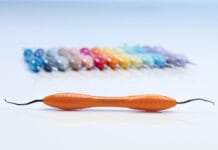The Journal of Dental Hygiene recently published a study that focused on a major occupational hazard commonly associated with dental professionals. The article, titled “Magnification and Coaxial Illumination in Dental Hygiene Education: Experience and Attitudes of Clinical Educators,” discussed how dental professionals are more at risk of developing musculoskeletal disorders and two potential prevention methods.
About Musculoskeletal Disorders
According to the World Health Organization, an estimated one third to one-fifth of all people have some sort of Musculoskeletal Disorder. Patients with Musculoskeletal Disorders usually have limited mobility, which can make it hard for them to move around and perform basic daily tasks. Besides their muscles, the disorder can also affect multiple sections of their musculoskeletal system including the blood vessels, tendons, nerves, and ligaments.
Certain people are more likely to develop a Musculoskeletal Disorder based on their gender, age, ethnicity, and socioeconomic status. Patients who smoke or are overweight are also high risk.
Research suggests that dental offices and similar work environments can significantly increase someone’s chances of developing the disorder. This is because Musculoskeletal Disorder is triggered when someone performs repetitive movements or similar tasks every day.
Common symptoms of Musculoskeletal Disorders include:
- Ruptured discs
- Tendonitis
- Carpal tunnel
- Epicondylitis
- Radial tunnel
- Digital neuritis
- Muscle strain
- Neck tension
- Ligament sprain
- Mechanical back syndrome
- Rotator cuff tendonitis
Certain jobs that involve a lot of highly repetitive movement can cause a strain on the body over time. It can also make their musculoskeletal system imbalanced. Awkward posture and lifting heavy weights improperly can contribute to the eventual formation of Musculoskeletal Disorders when the body does not have enough time to recover. Poor habits such as eating unhealthy food, not getting enough sleep, and dehydration are also contributing factors.
Luckily, people can prevent Musculoskeletal Disorders if they use certain precautions. The use of ergonomics, improved body mechanics, and better lifestyle habits can cause less physical stress on the body.
About the Clinical Study
Scientists Denise Kissell, Brian B. Partido, and Wendy Moore, wanted to see if certain dental instruments could help dental professionals make fewer repetitive movements and improve their posture.
For the study, the scientists visited a clinical dental hygiene program in Ohio and gave faculty members a cross-sectional survey. After the clinical dental hygiene educators completed the survey, the researchers noticed a stark pattern when they examined the results. A majority of the faculty members believed magnification loupes and coaxial illumination could significantly reduce the amount of repetitive movement and improve their posture.
Out of the 54 respondents, 86% used magnification loupes regularly in their role as clinical faculty members. An estimated 94% of them also believed clinical faculty members should use coaxial illumination in academic settings, while 92% of their students agreed.
Ultimately, the researchers found that dental faculty members and students supported the use of magnification loupes and coaxial illumination since it could help reduce their chances of developing Musculoskeletal Disorder in the future.
In Conclusion
Based on the study’s findings, dental professionals should be vigilant and try to stop certain behaviors that can put their health at risk. Continued education and tools such as magnification loupes and coaxial illumination can dramatically help improve their ergonomic posture, reduce the number of routine movements, and make it easier for them to be more efficient when they perform their job.
Besides using loupes with a light, dentists and dental hygienists should also pay attention to their daily lifestyle habits. Small changes such as getting more sleep, eating leafy greens, and other positive changes including improving posture and ergonomics when they are not at work may help decrease their chances of developing musculoskeletal disorders.











